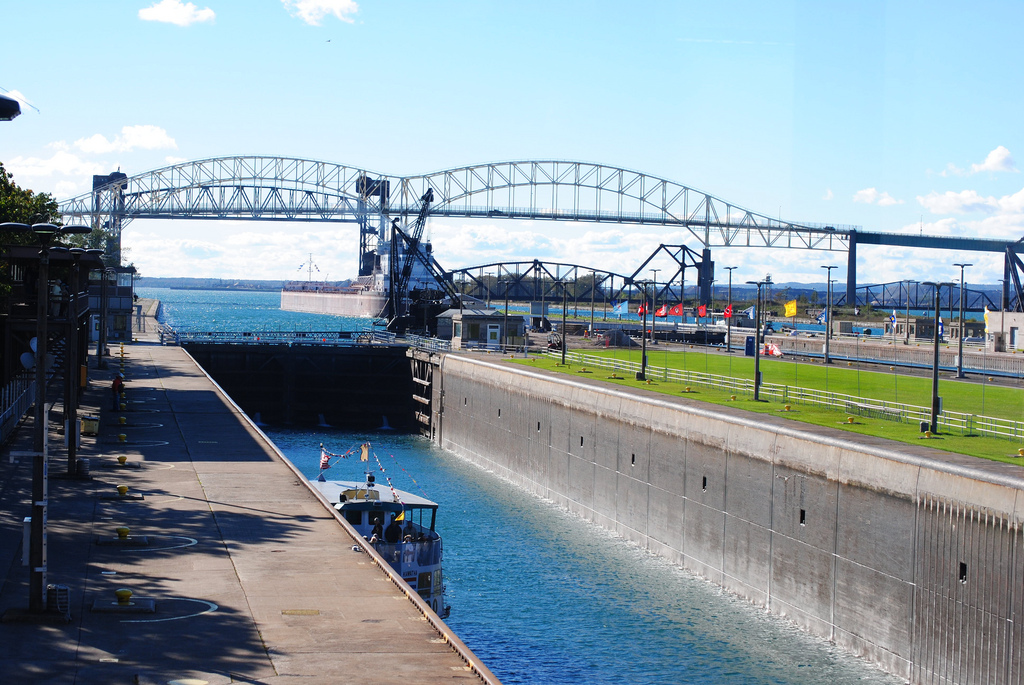
Soo Locks. Image: Missie, Flickr.
The decades-long effort to build a new lock connecting Lakes Superior and Huron at Sault Ste. Marie is getting renewed state attention. Advocates hope it will also be taken up by President-elect Donald Trump because of his infrastructure campaign pledge.
But it will be at least another year before the next step, a cost-benefit analysis by the Army Corps of Engineers.
“It’s so important,” said Linda Hoath, executive director of the Sault Area Visitor’s Convention and Bureau.
Not just for Michigan but for the whole region, she said.
The U.S. would lose $1.1 trillion if the existing lock capable of handling the biggest freighters breaks down for six months, according to a new report from Gov. Snyder’s 21st Century Infrastructure Commission. That report cited information from the Department of Homeland Security and encouraged a replacement for the aging Poe Lock as a failsafe to the nation’s economy.
The commission, created in the wake of the Flint water crisis that brought attention to the threat of aging water systems, released a 188-page report detailing the state’s infrastructure needs. It touches on transportation, communications and other issues.
Meanwhile, infrastructure was one of Trump’s key issues during his presidential campaign. He said he wants to spend $1 trillion on it.
Advocates say they hope Trump will push the construction of a new lock.
“It’s kind of the perfect project for everything he talked about in his campaign,” said Jim Weakley, president of the Lake Carriers Association, which represents Great Lakes shippers. “It’s very consistent with his national security comments, economic security interests and homeland security statements.”
A new lock would take a big bite of those funds. A 2005 estimated price tag was $580 million to complete it. Preliminary work w started in 2009-2010 but not completed. The money would come from the federal government.
The commission is calling for completion of a second lock capable of handling 1,000-foot freighters. In addition to the $1.1 trillion hit to the economy, the commission said a breakdown of the Poe Lock, which handles the largest freighters now, would kill 11 million jobs and cause a recession and bankruptcies.
The report says a second lock capable of handling the biggest ships would create the “redundancy” needed to save those jobs.
But it will be at least a year before anything can be done.
That’s because the Army Corps of Engineers would be esponsible for building the new lock and the project has to meet the agency’s cost-benefit standards. That means the benefits of the new lock and consequences of a Poe Lock breakdown must outweigh the cost of the project.
The last time the corps ran the numbers, the new lock didn’t measure up.
But key assumptions have changed. When the corps did the math in 2005, it assumed raw materials such as iron ore could simply be transported by rail if the Poe Lock were to break down, said Scott Thieme, deputy for project management in the Detroit district of the Army Corps of Engineers.
“We now know that we can’t,” Thieme said.
The railways simply don’t exist near the mines, said Tim Eder, executive director of the Great Lakes Commission, an organization created by the states to track environmental and economic issues in the Great Lakes states and Canada. If the Poe Lock were to fail, railways couldn’t be built fast enough to prevent the nation from feeling the pinch.
Seventy-five percent of all U.S. steel production would halt, Eder said.
The U.S. auto industry would start to shut down within six weeks, Weakley said.
Quoting the Department of Homeland Security’s report, he said, “It is hard to conceive a single asset more consequential than the Poe Lock.” A long-lasting Poe Lock failure would hurt Michigan’s unemployment rate hardest, with unemployment rates reaching 22.6 percent, Weakley said.
The corps is re-doing the math, but the Detroit division won’t know for sure if the new lock project meets its standards until December 2017, according to the commission’s report.
But Weakley thinks it will take even longer because there are two more steps the corps’ report goes through.
By then, it could be half-way through Trump’s presidency, Weakley said.
Building the new lock on the site of older, non-operational locks would take 10 years, Hoath said. “This would be far beyond anything we’ve ever had here,” since the last lock was built.
Building the lock would mean 1.5 million hours for middle-class workers, Weakley said. He wasn’t sure how many contractors would be local.
This story was reported by Capital News Service where it first appeared.